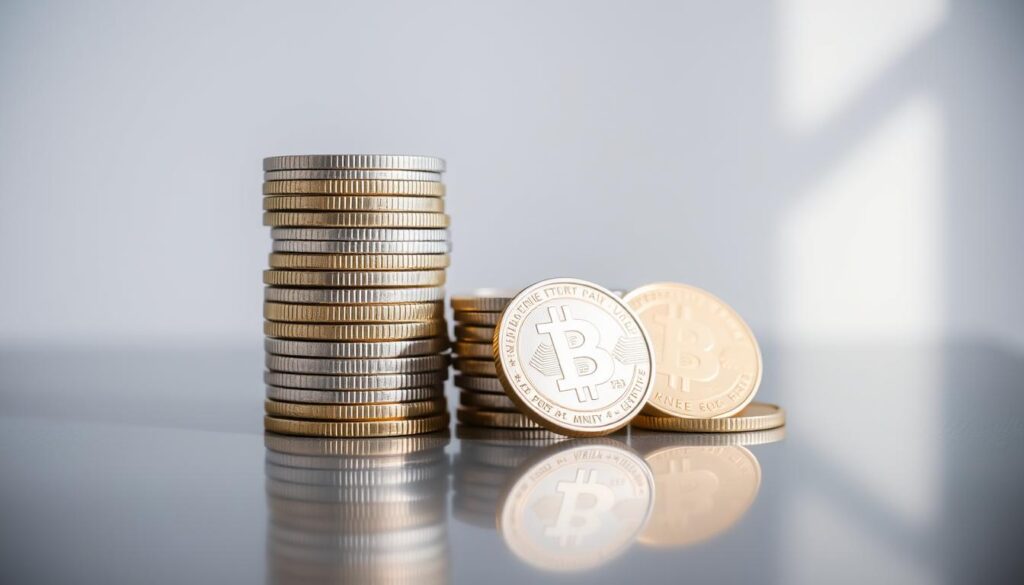Now Reading: Cross-Chain Crypto Trading: Revolutionize Your Investments
- 01
Cross-Chain Crypto Trading: Revolutionize Your Investments
Cross-Chain Crypto Trading: Revolutionize Your Investments

The way investors interact with digital markets is changing rapidly. Traditional single-network platforms no longer meet the demands of today’s decentralized economy. New solutions now let people move value freely between different blockchain systems—without middlemen or excessive fees.
Recent data shows explosive growth in this space, with transaction volumes jumping over 200% in just one year. Nearly 70% of investors now prioritize platforms that offer security and cost efficiency, according to industry surveys. This shift highlights a clear preference for peer-to-peer solutions that put users in control.
By connecting isolated blockchain ecosystems, this innovation unlocks access to global liquidity pools. Investors can diversify portfolios like never before, tapping into assets from multiple networks at once. No more silos. No more compromises.
The real breakthrough lies in ownership. Unlike traditional exchanges, these systems let users retain full control of their holdings during transactions. This approach aligns perfectly with the core principles of decentralized finance—transparency, autonomy, and accessibility.
Key Takeaways
- Transaction volume for multi-chain solutions grew 200% in 12 months
- 70% of investors prefer decentralized platforms for security and affordability
- Direct peer-to-peer swaps eliminate third-party risks
- Access to multiple networks enhances portfolio diversification
- Full asset control remains with users during transactions
Introduction to Decentralized Finance and Blockchain Interoperability
Blockchain technology is breaking down barriers in global finance. Decentralized finance (DeFi) reshapes how people access financial services by removing centralized control. Unlike traditional systems, these networks let users manage assets directly through peer-to-peer tools.

The Emergence of DeFi
Decentralized finance emerged as a solution to outdated banking models. Early platforms allowed basic transactions but operated in isolation. This limited access to assets outside their native blockchain networks, creating fragmented markets.
Modern decentralized exchanges changed the game. They enable direct swaps without third-party custody, giving users full ownership. Over 80% of these platforms now support multi-chain features, reflecting demand for broader connectivity.
Interoperability solves the puzzle of isolated systems. It lets different blockchain networks communicate, creating unified markets. Developers now prioritize this feature, with 65% of new projects focusing on cross-network compatibility.
The shift toward interconnected ecosystems marks a turning point. By bridging gaps between platforms, decentralized finance unlocks global opportunities while maintaining core principles: transparency and autonomy.
The Evolution of Cross-Chain Crypto Trading
Breaking free from single-network constraints revolutionized asset management. Early decentralized systems operated in isolation, forcing investors to juggle multiple platforms. This fragmentation reduced market efficiency and limited access to diverse digital holdings.
Centralized exchanges initially bridged this gap by holding user funds. While convenient, this approach exposed participants to custody risks and inflated fees. Surveys show 62% of users abandoned these platforms due to security concerns and lack of control.

Trustless protocols emerged as game-changers, enabling direct swaps between separate ledgers. These systems use cryptographic proofs to verify transactions across different blockchain networks without intermediaries. Early adopters focused on major pairs like BTC/ETH, proving the concept’s viability.
Developers faced hurdles maintaining security across varied consensus models. Solutions evolved to handle proof-of-work and proof-of-stake networks simultaneously, ensuring transaction finality matched single-chain reliability.
Modern interfaces now simplify complex interactions, letting users exchange assets across eight major networks through unified dashboards. This progression underscores a broader shift toward interconnected financial infrastructure.
Mechanisms Behind Cross-Chain Trading
Modern blockchain ecosystems rely on innovative protocols to move value between networks securely. Two primary methods dominate this space: atomic swaps and wrapped tokens. Each approach solves interoperability challenges while maintaining decentralized principles.

Atomic Swaps and Smart Contracts
Atomic swaps enable direct peer-to-peer exchanges between separate ledgers. These trustless transactions use smart contracts to lock assets until both parties confirm conditions. For example, if Alice trades Bitcoin for Bob’s Ethereum, cryptographic proofs verify the swap simultaneously.
The process relies on hash-time locked contracts (HTLCs). These digital agreements automatically reverse incomplete transactions, preventing losses. No third party holds funds—ownership stays with users until the swap finalizes.
Understanding Wrapped Tokens
Wrapped tokens bridge networks by representing assets from one blockchain on another. Think of them as digital passports letting Bitcoin operate on Ethereum or Solana. A custodian locks the original asset and mints equivalent tokens on the target network.
Popular examples like Wrapped Bitcoin (WBTC) demonstrate this system’s efficiency. Users gain access to diverse markets without leaving their preferred blockchain. Value remains pegged 1:1 through audited smart contracts.
Exploring Cross-Chain Bridges and Trading Solutions
Financial ecosystems gain strength through connection. Specialized protocols now link isolated ledgers, creating pathways for value movement without centralized oversight. These systems empower users to interact with assets across multiple environments while preserving security.
How Cross-Chain Bridges Connect Blockchains
Cross-chain bridges act as translators between different blockchain systems. When transferring assets, the protocol locks originals in smart contracts and mints equivalent tokens on the target network. For example, sending Ethereum through a bridge creates wrapped ETH usable on Solana or Avalanche.
Leading solutions like Thorchain and Wormhole use decentralized validation. This ensures no single entity controls the process. Users retain ownership throughout transfers—a critical upgrade from traditional exchange models.
Benefits of Using Token Wrapping
Wrapped tokens unlock liquidity pools across blockchain networks. They let Bitcoin holders participate in Ethereum-based derivatives markets or stake stablecoins on Polygon. This flexibility fuels complex strategies like arbitrage and yield farming.
By eliminating intermediaries, bridges reduce fees and custody risks. Investors access global opportunities while maintaining direct control—a balance previously unattainable in fragmented markets.
Security Considerations and Overcoming Trading Challenges
Navigating decentralized markets requires balancing opportunity with risk awareness. As platforms grow more interconnected, understanding potential pitfalls becomes as crucial as spotting advantages. Let’s explore critical safeguards for protecting assets while maintaining operational efficiency.
Addressing Smart Contract Vulnerabilities
Smart contracts power most decentralized systems, but flawed code can expose funds. Recent incidents show how attackers exploit loopholes in bridge protocols. Always verify third-party audits before using platforms—reputable services publish these reports publicly.
Conduct test transactions with small amounts first. This practice helps identify issues without risking significant holdings. Platforms with multi-signature approval processes add extra security layers, reducing single-point failure risks.
Managing Gas Fees and Transaction Complexities
Network costs vary wildly between systems. Ethereum’s fees might drain small budgets, while Solana offers cheaper alternatives. Calculate total expenses—including failed attempts—before initiating transfers. Keep reserves for unexpected price spikes during busy periods.
Common errors like insufficient gas or expired approvals disrupt operations. Use wallet tools that auto-estimate requirements across networks. For time-sensitive swaps, prioritize platforms with instant failure notifications to minimize delays.
- Review bridge liquidity levels before large transfers
- Bookmark transaction explorers for real-time tracking
- Avoid platforms holding user funds in centralized exchanges
Future Trends in Decentralized Exchanges and Blockchain Interoperability
The next evolution of financial systems lies in seamless connectivity between independent ledgers. Developers are creating tools that let users interact with assets different blockchains through unified interfaces. This shift removes technical barriers while preserving the core benefits of decentralized networks.
Innovations in Layer 2 Solutions and Advanced Protocols
Layer 2 scaling methods like Optimistic Rollups slash transaction costs by 90% compared to base networks. These solutions process thousands of swaps per second while maintaining security. Platforms now integrate these protocols to support instant transfers across different blockchain environments.
New bridge designs use decentralized validation to move tokens between networks safely. Projects like Wormhole employ advanced cryptography to prevent exploits. As highlighted in recent analysis, these upgrades position decentralized exchanges as multi-chain hubs by default.
Emerging standards enable direct access to services on different blockchains without manual conversions. Users soon won’t need wrapped tokens—systems will auto-convert assets during transfers. This leap forward simplifies portfolio management while expanding access to global liquidity pools.
FAQ
How do assets move between separate blockchain networks?
Specialized protocols called bridges enable transfers by locking tokens on one chain and minting equivalent assets on another. These systems rely on smart contracts to ensure secure, trustless transactions without centralized intermediaries.
What role do wrapped tokens play in decentralized exchanges?
Wrapped tokens act as representations of assets from foreign chains, allowing them to function within a new ecosystem. For example, Wrapped Bitcoin (WBTC) lets Bitcoin holders participate in Ethereum-based DeFi platforms.
Are transactions involving multiple chains more expensive?
Costs vary based on network congestion and bridge fees. Layer 2 solutions like Optimism or Arbitrum help reduce gas fees by processing transactions off-chain before settling on the main network.
What risks exist when using interoperability protocols?
Vulnerabilities in smart contracts or bridge designs can expose funds to exploits. Platforms like Chainlink’s CCIP enhance security by using decentralized oracle networks to verify cross-chain activities.
Can decentralized exchanges handle swaps across incompatible networks?
Advanced DEXs leverage atomic swaps and hashed timelock contracts to facilitate peer-to-peer trades without intermediaries. Thorchain and similar platforms specialize in these trustless, multi-network transactions.
How do layer 2 innovations improve blockchain interoperability?
Solutions like Polygon’s zkEVM or StarkNet’s validity rolls compress transaction data, enabling faster and cheaper transfers while maintaining compatibility with major chains like Ethereum.
Why do some wrapped assets lose parity with their originals?
Price deviations occur due to liquidity imbalances or bridge inefficiencies. Automated market makers on DEXs often correct these discrepancies through arbitrage opportunities.















